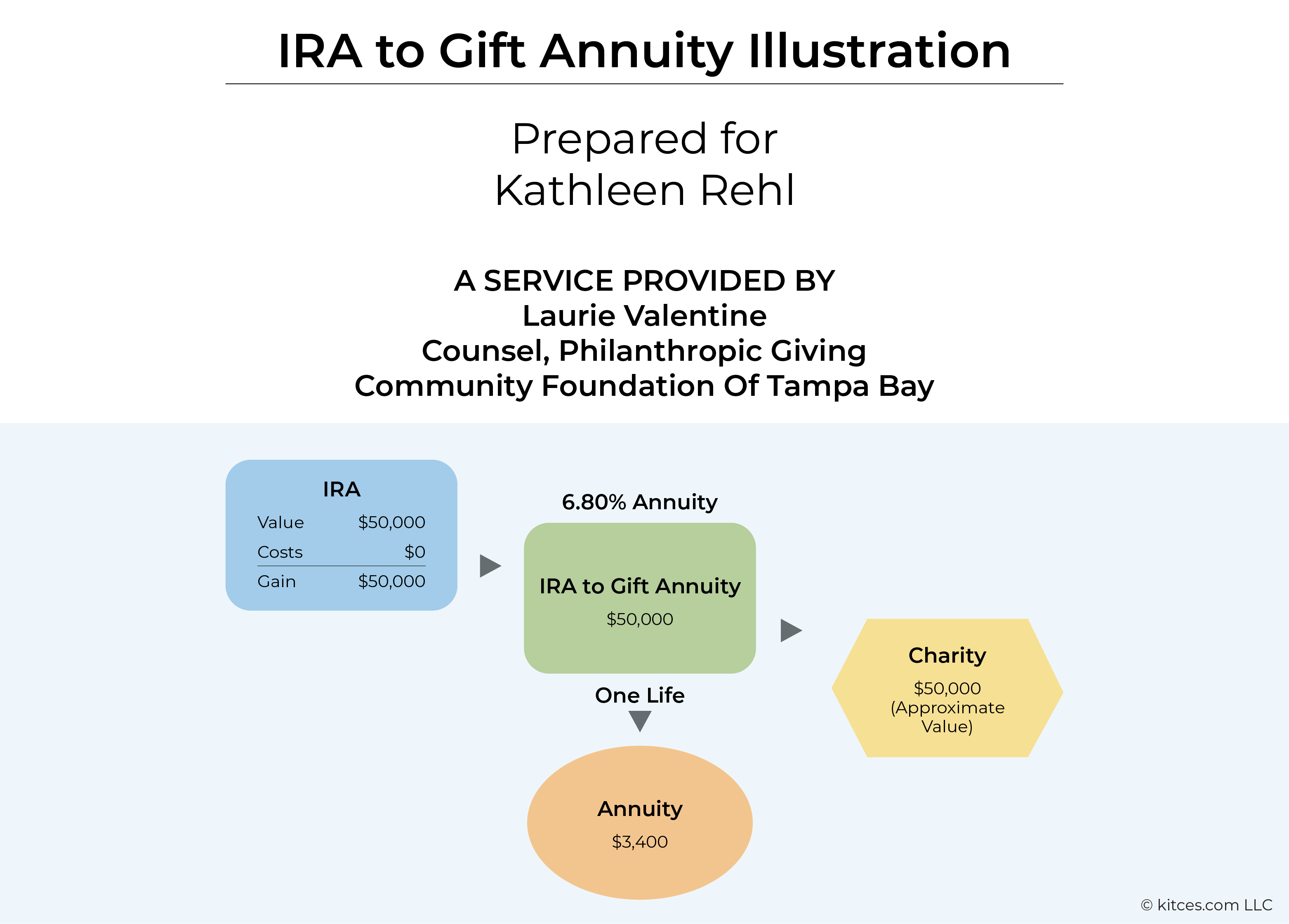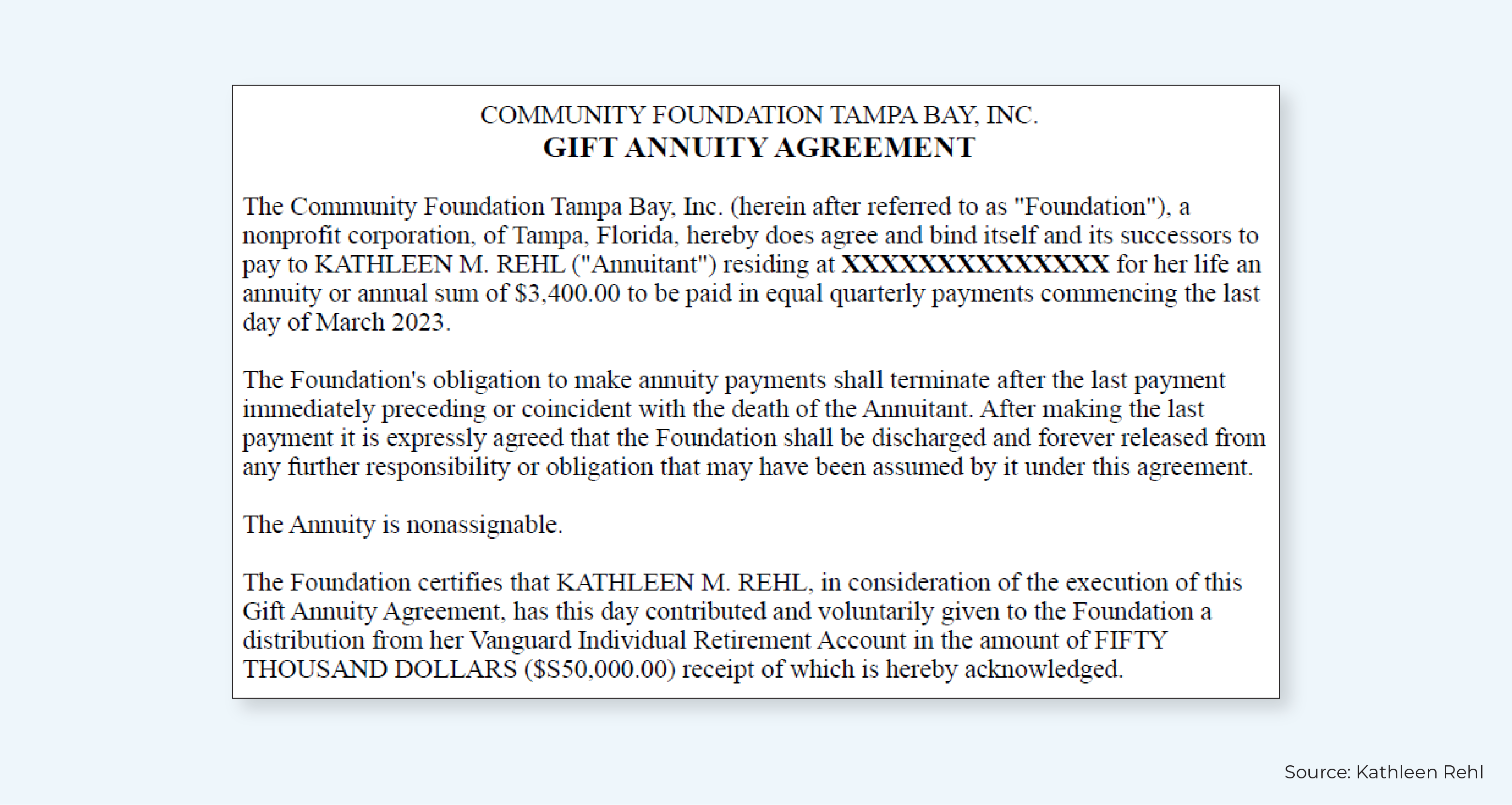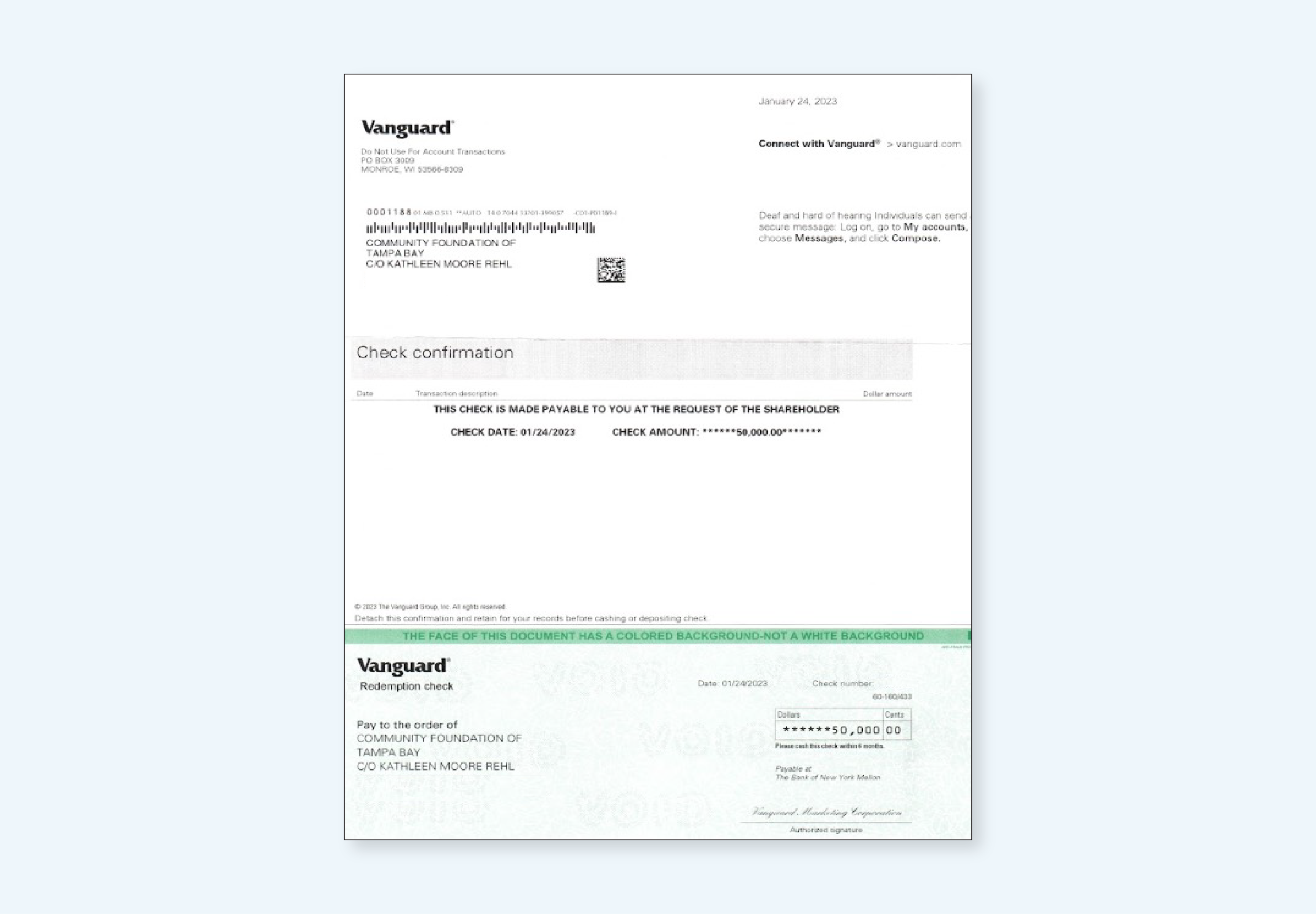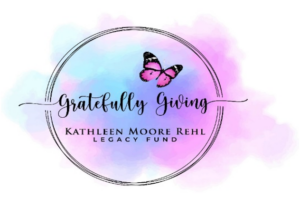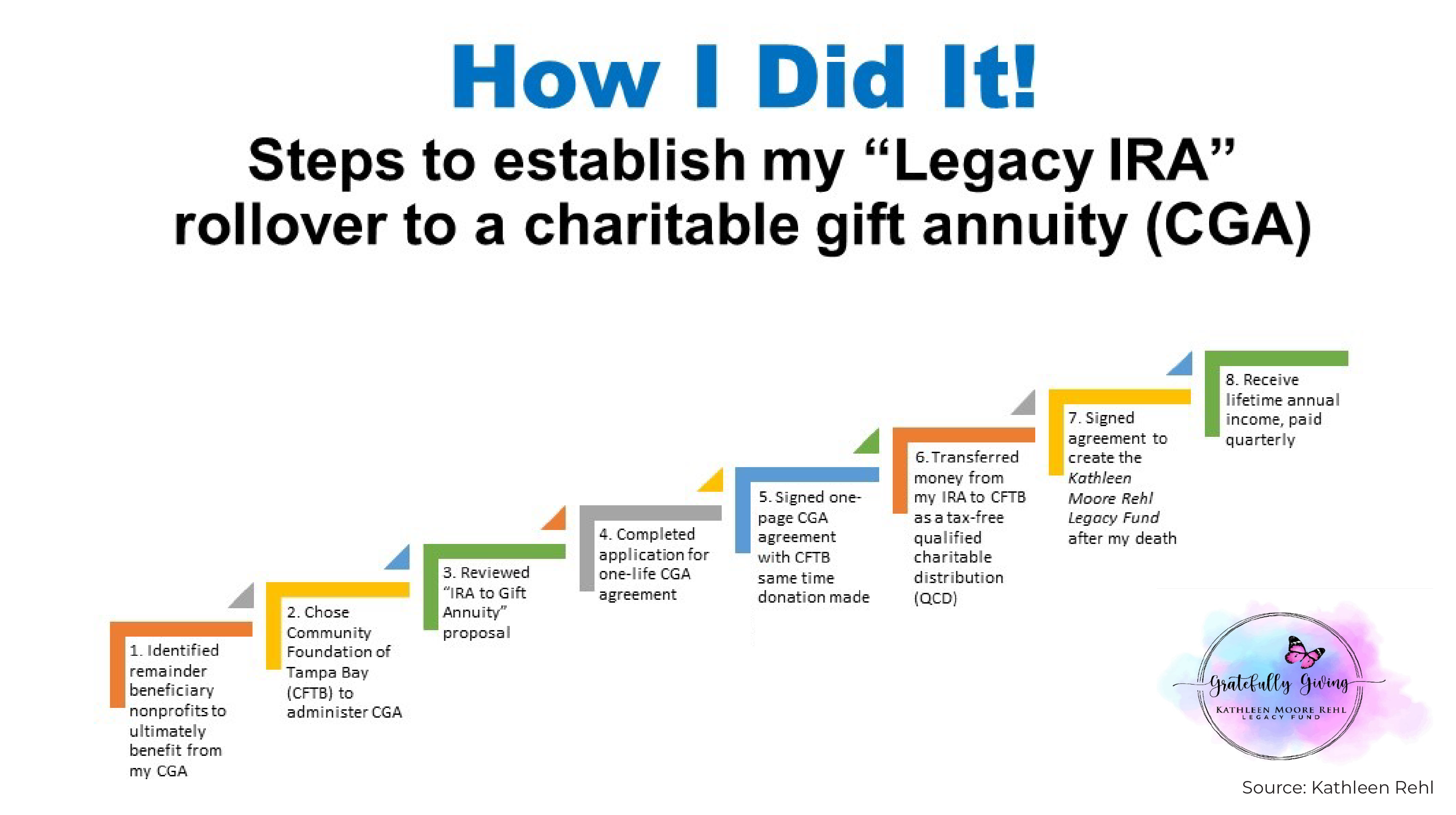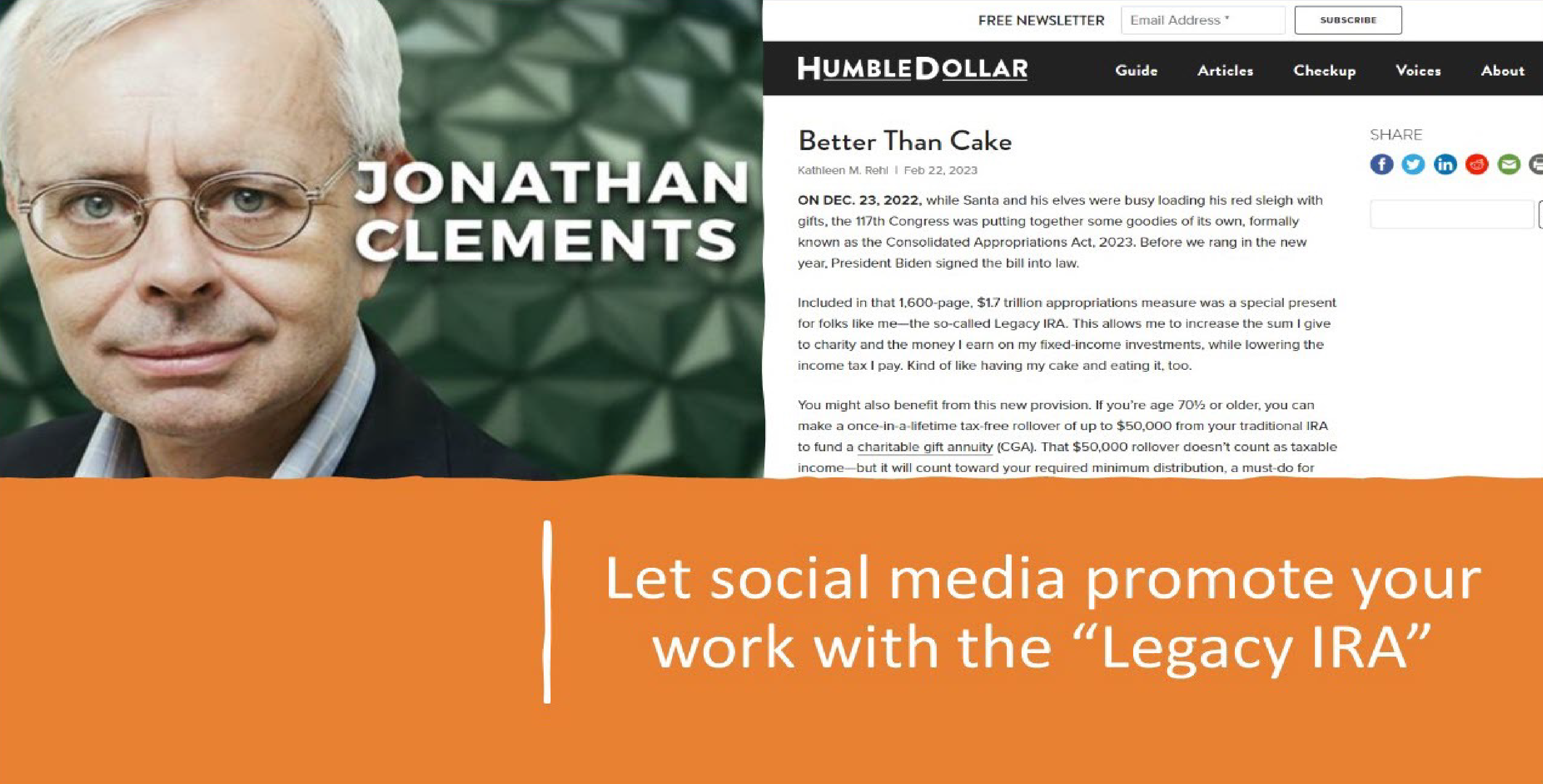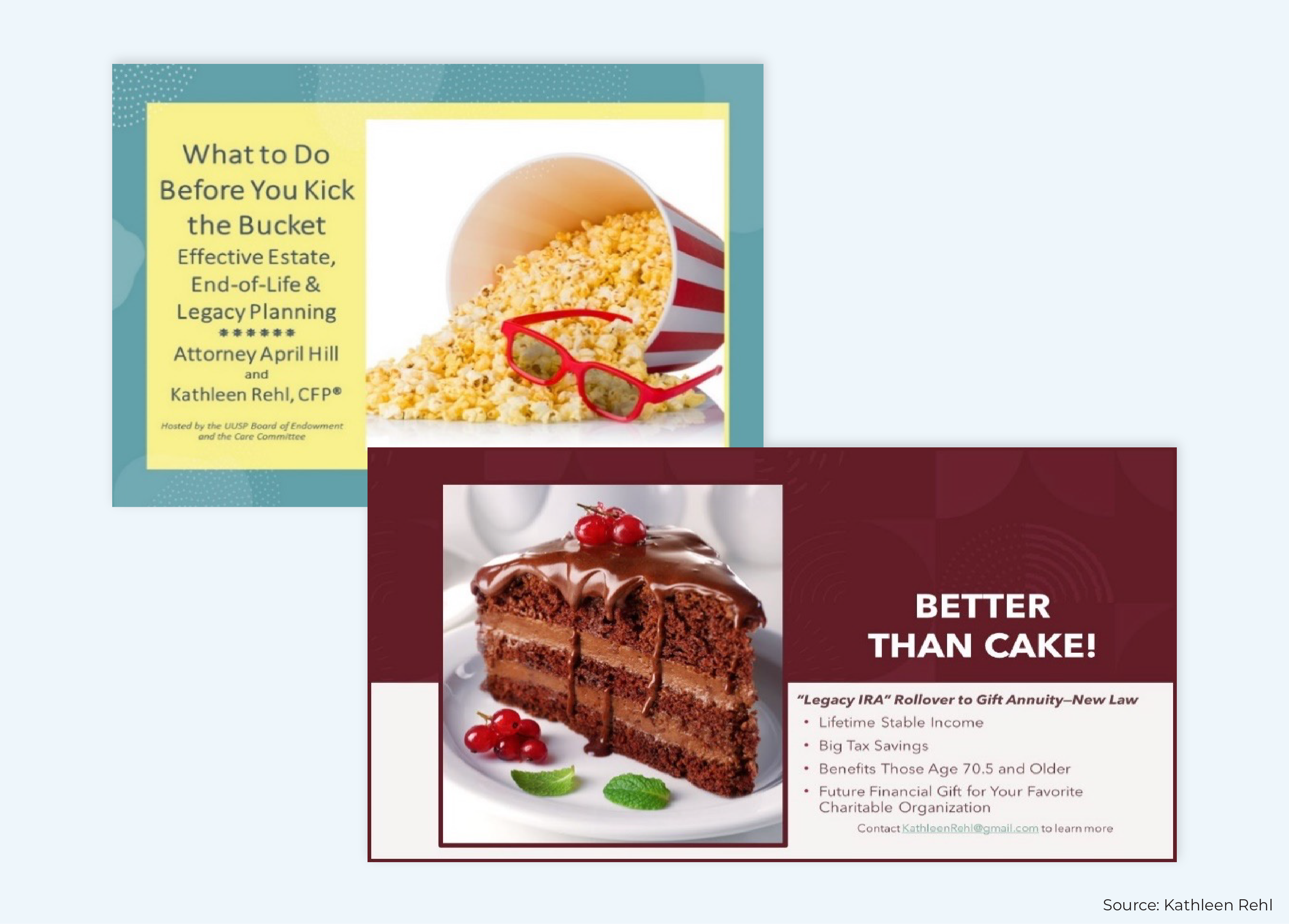Executive Summary
Charitable Gift Annuities (CGAs) have long been a popular way for individuals with charitable intentions to plan their legacies. By contributing a lump sum to a charity in exchange for fixed recurring payments for life (with any leftover funds after the donor's death going to the charity), the individual can ensure that their funds are directed towards a purpose that aligns with their values, while also retaining a steady source of income for the rest of their life. However, the caveat with current CGAs has been that they could only be funded with after-tax dollars before the donor’s death, meaning that if an individual only had tax-deferred funds (e.g., in an IRA or 401(k) plan) to contribute to the Charitable Gift Annuity, they would need to withdraw – and be taxed on – those funds first. Testamentary CGAs, on the other hand, can be established after a donor’s death, funded with IRA or other assets to provide income for another person. But the SECURE 2.0 Act, passed in December 2022, created the ability for individuals over age 70 1/2 to make a one-time Qualified Charitable Distribution (QCD) of up to $50,000 of IRA funds into a CGA, with the amount distributed to the CGA being excludable from the donor's taxable income.
In this guest post, Kathleen Rehl, a semi-retired financial advisor and educator now focusing on her own estate planning considerations, shares her experience with creating her "Legacy IRA" rollover to a Charitable Gift Annuity to support her chosen nonprofits after Congress passed the SECURE 2.0 legislation at the end of 2022.
The potential benefits of the new Legacy IRA rules are threefold. First, they allow donors to enhance their charitable giving legacy and ensure their future charitable intentions are fulfilled. Second, they reduce the donor's tax bill in the year the CGA is created by excluding the amount contributed to the CGA from taxable income. And third, they create a stable lifetime income stream that can be paid to the donor and/or their spouse.
All of which is important during a time when members of the Baby Boomer generation, who have accumulated unprecedented levels of wealth compared to previous generations, are preparing to make decisions on how to balance their intentions for transferring that wealth – whether that be passing it on to the next generation of family members or friends, or providing for causes that are meaningful to them – with their own needs for sustainable retirement income. And while a Legacy IRA may only be one piece of the puzzle (since the $50,000-per-person lifetime limit may only represent a small portion of the assets of many high-net-worth families), it can still serve as a unique and valuable legacy and tax planning tool – and given the minimal expense and hassle of setting up and maintaining the CGA (since the charitable organization typically handles all of the administrative aspects of doing so), there may be no reason for any individual with charitable intentions and lifetime income needs not to use it to the extent that the one-time $50,000 limit allows!
Ultimately, for financial advisors, the Legacy IRA can be one part of a broader toolkit for helping retired clients with values-based, purposeful legacy planning. By understanding the eligibility requirements and rules around the new law and gift annuities in general, and having a 'recipe' that clients can follow for establishing their own Legacy IRAs, advisors can help plant the seeds with their clients around strategic giving (while also differentiating themselves to potential new clients as a go-to resource for estate planning and charitable giving)!
My Values Align With Charitable Giving
I grew up on a small Wisconsin farm. With my parents working day jobs in town and tackling farm chores evenings and weekends, we still struggled financially. However, Mom and Dad managed to give back to their community by putting a little in the church offering plate passed on Sundays. Those charitable seeds planted decades ago became the basis for my purposeful philanthropic philosophy and my charitable stance today. I also believe that the more I give, the more I get in return—meeting interesting people, enjoying remarkable experiences, creating new ways of seeing the world, savoring fun times with loved ones, and sometimes even benefiting financially.
It's said that we are happiest when our lives have meaning and have a positive impact. That includes expressing gratitude for the blessings I've received during my lifetime. One way I can actively demonstrate appreciation is through my giving. Especially during our current (unprecedented) time of intergenerational wealth transfer and the longevity economy, there are implications for philanthropy and other Boomers like me. For example, it's not my goal to leave everything I've worked a lifetime for to my family. Instead, I've arranged for them to inherit some while providing for charities I cherish. Many of my friends mirror this view.
Some folks like to follow a recipe, a cookbook of sorts; such readers will find that offered here in my story, where I share my own experience of how I established a "Legacy IRA" (made available through the SECURE 2.0 Act of 2023) to a Charitable Giving Annuity (CGA), in part to encourage those who are charitably inclined and meet the eligibility requirement of the new law to think about establishing their own personal Legacy IRAs. This tool can be especially useful for middle-income Americans who appreciate the tax benefits in addition to the income they receive. Additionally, Legacy IRAs offer a remarkable opportunity to enhance future charitable giving, decrease taxable income, and increase fixed-income earnings.
I hope my story inspires financial advisors to consider including Legacy IRAs as a new tool in their toolkits when helping retired clients with values-based, purposeful legacy planning.

Nerd Note:
For additional perspectives about Kathleen's work, Michael interviewed her on the Financial Advisor Success Podcast Episode 106: Empowering Widows Financially By Helping Them Navigate the 3 Stages of Widowhood.
The "Legacy IRA" Is Born
In the final week of 2022, most folks were getting ready to ring in the New Year. But on December 23, 2022, the 117th United States Congress was working to pass SECURE 2.0, formally known as the Consolidated Appropriations Act of 2023 (H.R. 2617). This massive $1.7 trillion spending bill included a unique present for people who want to give to charity and get tax breaks simultaneously. Section 307 of the SECURE Act 2.0 permits a once-in-a-lifetime IRA rollover to an income plan that gives them regular payments throughout their lifetime.
Notably, this new law expands the 'charitable IRA rollover', achieved after more than a decade of lobbying efforts. IRC Section 408(d)(8) was introduced in 2006 as a temporary solution, extended several times, and made permanent in 2015. It allowed those aged 70 1/2 years and older to make an outright gift as a Qualified Charitable Distribution (QCD) of up to $100,000 from their IRA.
As of January 1, 2023, a QCD of up to $50,000 is now allowed for individuals aged 70 1/2 or older to create a "Legacy IRA", which generally involves a traditional IRA rollover to a Charitable Gift Annuity (CGA; explained in more detail below). Depending on the minimum level designated by the administering nonprofit, a lesser amount is possible, though most organizations require at least $10,000. Additional assets cannot be added later. This limited one-time Legacy IRA rollover into a life income plan was made possible by amending Internal Revenue Code Section 408(d)(8).
Life-income gifts were not permitted before, but now 3 types are allowed: an immediate Charitable Gift Annuity (CGA), a standard payout Charitable Remainder UniTrust (CRUT), or a non-assignable Charitable Remainder Annuity Trust (CRAT). Although CRUTs and CRATs are allowable, logistics generally rule out these 2 alternatives. For example, most charitable remainder trusts are typically funded at no less than$100,000 to be financially sustainable. Which means the $100,000 QCD limit can make it difficult to substantiate the setup of a CRAT or CRUT.
What Is A Charitable Gift Annuity (CGA)?
A Charitable Gift Annuity (CGA), defined by IRC 501(m)(5), combines a life annuity with an irrevocable charitable donation. It's a contract between an individual or couple and a nonprofit. In exchange for the donor's gift, the nonprofit agrees to pay a fixed income to the donor (or the donor and their spouse) for their lifetime. When the income recipient dies, the annuity stops, and the remaining principal goes to the nonprofit specified in the gift annuity contract. With this traditional, vanilla-style CGA, it's possible to create a gift annuity that pays income to someone other than the donor or the donor and their spouse. For example, I could create a CGA to provide lifetime income for my 60-year-old son. (Many charitable organizations that administer CGAs set the minimum age to be 60 for income recipients.)
CGA payout rates typically follow guidelines set by the American Council on Gift Annuities. The income payments are made to the individual for their lifetime. Depending on how a traditional CGA (i.e., with contributions not from an IRA) is funded, the income payments may be classified as part tax-free return of principal, part capital gain, or part ordinary income.
CGAs are usually managed by reputable large nonprofits, including community foundations, universities, religious groups, human rights advocates, and cultural arts organizations. These charitable organizations accept and invest contributions from various CGAs, pooling reserve funds for effective management and distribution. The annual payment amounts are based on the donor's age at the time of the contribution.
Notably, upon the donor's passing, any remaining funds in the CGA will be allocated to the chosen nonprofit(s) either as an endowed gift or as an outright cash gift. Depending on the organization administering the CGA, donors may specify different charities to benefit from the legacy beyond their lifetime.
With the new Legacy IRA, IRA rollovers to a CGA are considered gifts that are not tax-deductible, but the tax-free IRA distribution could, if applicable, count toward the donor's required minimum distributions for the year. So the amount rolled to a CGA can simultaneously fulfill part or all of the year's annual Required Minimum Distribution (RMD), benefiting donors age 73 (as RMDs begin for those reaching age 72 after December 31, 2022) or older. All income payments from this Legacy IRA rollover gift annuity are designated as ordinary income.
My Steps To Establish A Legacy IRA To A Charitable Gift Annuity (CGA)
Consider my situation.
Throughout my working years to age 73, I diligently funded several tax-deferred retirement accounts, including a traditional IRA and various employer plans. In my early 70s, I merged those various accounts (except for a Roth IRA and an inherited IRA) into my traditional IRA at Vanguard. With most of my living expenses today covered by Social Security, 2 small pensions, and other investments, I withdraw only the required minimum distribution each year, which, for 2023, amounts to nearly $63,000. However, this mandatory withdrawal, which I don't need to live on, pushes me into a higher tax bracket, with more income tax due!
By rolling over the maximum allowable amount of $50,000 from my IRA to a Charitable Gift Annuity (CGA), I will owe income tax only on the remaining RMD amount of $63,000 (total RMD amount) − $50,000 (rollover to CGA) = $13,000. The CGA gives me a stable, secure income for life, with the payout rate determined by my age. Signing my CGA contract at age 76, I now receive an attractive fixed payout rate of 6.8% on the $50,000 gift.
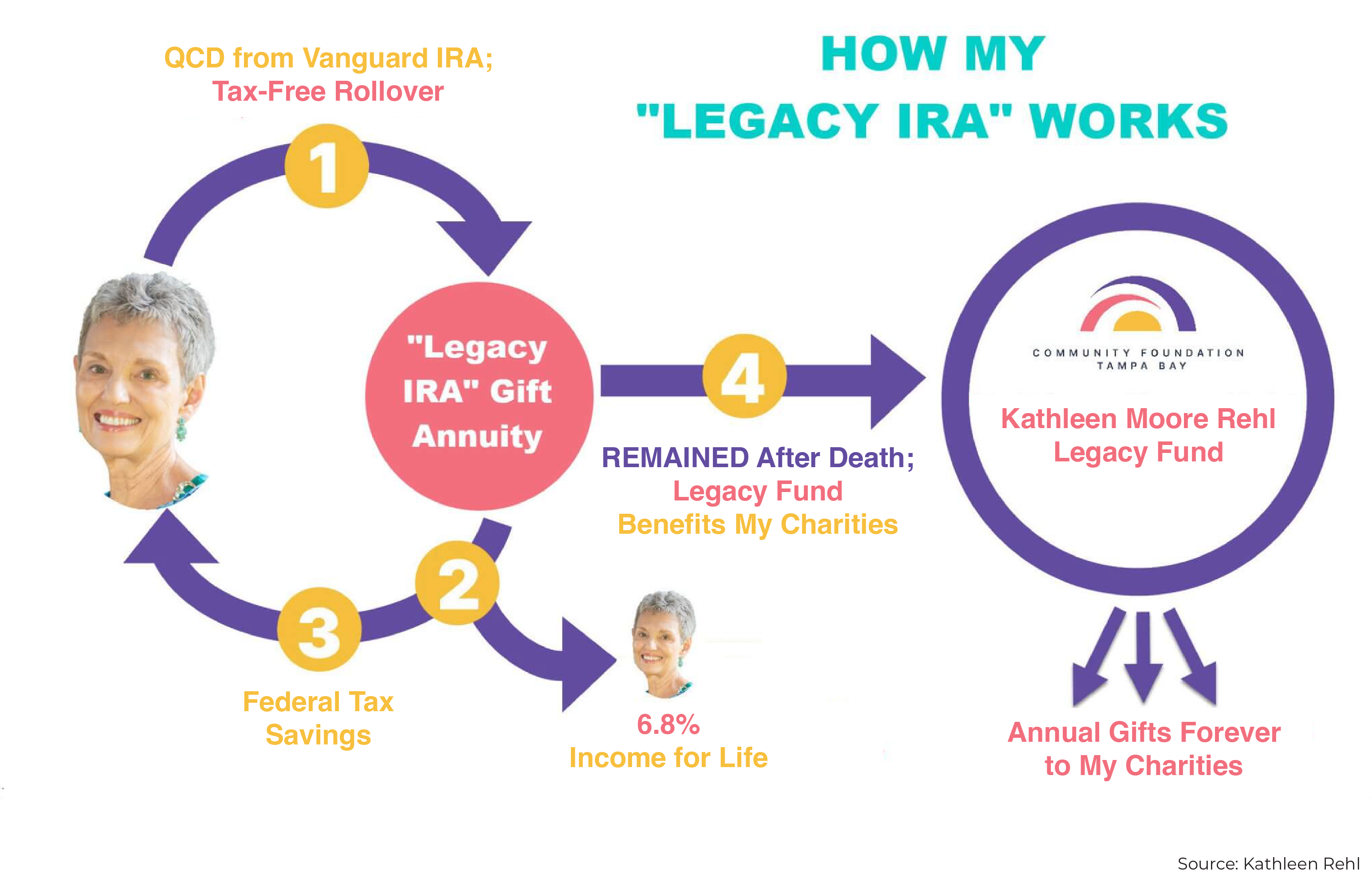
Alternatively, if I had included my younger spouse as a joint beneficiary until the second of us passed, the rate would have dropped to 5.9%. Considering that we remarried later in life after both of us were widowed years before and are both financially independent, I chose a single-life payout for myself only. Hubby agreed.
More About Exactly How I Did It!
While setting up a Legacy IRA is relatively simple, there are several steps involved. Here are the details of the process I followed to establish my own Legacy IRA:
- Identified the charitable organizations I wanted to support with continuing financial gifts after I die. I named Soaring Spirits International, a nonprofit benefiting widowed persons and 2 religious congregations. I currently contribute to these 3 charitable organizations regularly. I liked the idea of providing support for them after I'm gone, through a legacy fund that would keep giving in perpetuity.
- Chose the Community Foundation of Tampa Bay (CFTB) to administer my CGA. I selected them because I already have a donor-advised fund with this outstanding nonprofit. Also, since I wanted to benefit 3 different nonprofits through an endowment-type fund, I chose to work with an organization that could accommodate this request. When I approached CFTB, they were excited about helping me establish what would become CFTB's first Legacy IRA.
- Reviewed the IRA-to-Gift-Annuity illustration prepared by CFTB with Crescendo Interactive, Inc. Since I had used this software for gifting illustrations with my financial planning clients over the years, I was familiar with this powerful program.
Crescendo Interactive produces simple graphics for donors and technical number crunching that financial advisors, wealth managers, attorneys, and accountants love. This software even creates optional pages of a comprehensive explanation for professional advisors, which is helpful for those less familiar with the IRA rollover to a gift annuity. Charts and tables galore!
- Completed the brief application for a One-Life CGA agreement prepared by CFTB.
- Signed a 1-page CGA agreement prepared by CFTB.
- Transferred $50,000 from my Vanguard traditional IRA to CFTB as a tax-free Qualified Charitable Distribution (QCD). That was easy to do online, designating that the check be paid directly to CFTB. Giving this money to a nonprofit rather than to me as a required distribution will save me $12,000 in Federal tax this year (in the 24% federal marginal tax bracket). It also reduces my Medicare Income-Related Monthly Adjustment Amount (IRMAA) premium and the 3.8% surtax on net investment income.
- Signed the accompanying agreement to create the Kathleen Moore Rehl Legacy Fund.
 When I die, the remaining balance in my CGA will be transferred to my legacy fund, an endowment of sorts for the benefit of my 3 named charitable organizations. Annual distributions will be made forever. This "Kathleen Moore Rehl Legacy Fund" ensures that my support for these nonprofits continues long after I'm gone. Plus, I can direct additional money to this Legacy Fund from other sources besides my Legacy IRA if I desire. I anticipate doing this, providing more ongoing endowed income for the nonprofits that my legacy fund will support.
When I die, the remaining balance in my CGA will be transferred to my legacy fund, an endowment of sorts for the benefit of my 3 named charitable organizations. Annual distributions will be made forever. This "Kathleen Moore Rehl Legacy Fund" ensures that my support for these nonprofits continues long after I'm gone. Plus, I can direct additional money to this Legacy Fund from other sources besides my Legacy IRA if I desire. I anticipate doing this, providing more ongoing endowed income for the nonprofits that my legacy fund will support. - Now, I'm receiving income from my CGA. The first deposit of income from my CGA was made in my bank checking account at the end of March. This fixed, stable income will be paid to me quarterly for the rest of my life, regardless of market fluctuations. In my case, I receive $3,400 annually based on my age of 76. That's a 6.8% rate. Even if I outlive my life expectancy, I'll continue to get this income. I used to tell my clients that setting up a gift annuity would automatically guarantee a longer life span. Indeed, a 2020 global study conducted by Tobias Vogt, Fanny Kluge, and Ronald Lee, published in the Proceedings of The National Academy of Sciences (PNAS), suggests that generosity may help us live longer! Who knew?
How Advisors Can Help Clients Benefit From Legacy IRAs
Advisors with clients who are 70 1/2 years old or more have a unique opportunity to help them support charitable causes and increase their retirement income, plus enjoy tax benefits with the Legacy IRA. By transferring some money from their traditional IRA to a Charitable Gift Annuity (CGA), older clients can appreciate a steady stream of income for life while also getting Qualified Charitable Distribution related tax benefits, including possibly reduced IRMAA Medicare premium surcharges and the 3.8% investment income surtax reductions.
All this, plus the satisfaction of making a lasting impact on the nonprofit organizations they care about. Although some restrictions apply, the Legacy IRA is a valuable option for those who want a beneficial solution that aligns with their financial and philanthropic goals. For advisors like me, enjoying life as a septuagenarian or older, a Legacy IRA may benefit them personally as well!
Retirees May Find These Legacy IRA Benefits Attractive
There are several ways for retirees to enjoy the benefits of Legacy IRAs in their overall financial planning:
- A named legacy fund. My Legacy IRA puts plans in place for the Kathleen Moore Rehl Legacy Fund at the Community Foundation of Tampa Bay. No need to buy an entire wing of a new building for my name to be attached to this giving fund!
- Tax advantages. The rollover distribution to a CGA is tax-free and particularly beneficial for individuals who don't itemize their deductions. Additionally, it may help reduce Medicare surcharge premiums and the net investment income surtax if applicable. (Of course, an outright gift to a charity provides a tax advantage, too, but without giving the donor an income.)
- Higher-income rates. The income payout rate locked in with a CGA is generally more favorable compared to rates offered by certificates of deposit or government bonds. This stable income is secure for life.
- Retirement income now and a charitable gift in the future. The Legacy IRA allows one to supplement retirement income today while supporting their favorite charitable causes in the future after death. It's a win-win situation that, for me, aligns personal values with financial goals. It's a good fit for donors who may need some of their IRA distributions for living expenses.
- Stable lifetime income. The administering nonprofit's full faith and financial assets stand behind its commitment to providing income payments.
- No expense for the donor. Nonprofit organizations typically handle the administrative aspects of establishing the CGA and ensure the funds are managed efficiently and distributed to the charitable organization beneficiaries on a timely basis.
Special Considerations And Limitations Of Legacy IRAs
While the Legacy IRA offers compelling advantages, there are some considerations and limitations to keep in mind:
- One-time use. The Legacy IRA option can only be utilized once within 1 calendar year, and the funds must come from an individual's traditional IRA. It does not apply to other retirement accounts, such as 403(b) or 401(k) plans. However, it may be possible to move money from one of those accounts to a traditional IRA first and then do the Legacy IRA rollover with that money.
- More than 1 Legacy IRA can be established. It's possible to do a $20,000 Legacy IRA with 1 charitable organization and use up to a total of another $30,000 for a second or third CGA rollover, but they all must be created in 1 calendar year, and no more than a total of $50,000 combined can be moved to fund any number of CGAs.
- Spousal restriction. CGA income payments can't go to a non-spouse.
- Deferred payments are not permitted. It's not possible to push out income to the future. Annual payments must be paid out every year as scheduled.
- Tax implications. The annual income payments from the CGA are subject to ordinary income tax. However, the tax burden is spread out throughout one's lifetime.
- Inflation may erode the purchasing power of future payments received.
- Some state regulations may apply. Depending on the state, some charities may be required to meet specific years of existence and/or minimum asset requirements and to provide donors with certain disclosures before allowing donors to designate them as CGA beneficiaries.
- CGA payouts tend to be lower than those of traditional annuities because the primary motive is to benefit a charity rather than provide the highest possible retirement income payment.
Plant Seeds With Clients And Others About The Legacy IRA
Here are some ways for advisors to introduce the conversation about Legacy IRAs with clients:
- Use social media. Position yourself as the go-to professional who can help folks with a Legacy IRA. Write a story for lay audiences or do an interview highlighting the benefits and limitations of this approach. Then feature this on your website, Facebook, LinkedIn, and other sites your clients and colleagues visit.
- Make a presentation about this fast-growing area of philanthropy for your local council of the National Association of Charitable Gift Planners. This Spring, I was invited to speak about "Widows, Wives, & Friends: Beyond Basic Estate Planning PLUS the Legacy IRA" (the downloadable PowerPoint presentation focuses on Legacy IRAs on slides 29–33.) I'll make a similar presentation for my local council of the National Association of Estate Planners & Councils, and a group of retired financial planners, later this Fall. Plus I was recently invited to make a presentation on this topic and more during a national 5-part financial webinar series for women. Several other nonprofits have asked me to talk about Legacy IRAs. The first image below is the opening slide of a presentation I made this Spring with an estate planning attorney. The second image features a graphic I created to promote my presentation. Nonprofits welcome these presentations that inform their members and encourage charitable gifts to those organizations.
-
- Feature the Legacy IRA in other educational activities you’re involved with. For example, I made the following 1-minute video with easy-to-use Animoto software, highlighting several types of planned gifts that I’m sharing with selected individuals who are considering special charitable gifts. This piques their interest as they asked more about the stories included. It will also be part of a video trailer for a graduate course I’ll teach in 2024.
- Engage in meaningful and authentic conversations with your clients and donors about this Legacy IRA option that can be a powerful part of their values-based legacy and estate planning in retirement. Indeed, I'm now assisting several to set up their own Legacy IRAs, following discussions about what matters most to them and how this program can be beneficial. These conversations typically include their professional financial planners since I no longer provide comprehensive financial planning services for individuals.
But Wait—There's More! My Own Legacy Of Charitable Giving
For readers who care to know more about my planned charitable giving initiatives beyond my typical annual giving, an occasional capital campaign contribution, and quick 'checkbook giving', I've created or put documents in place for enabling 5 special giving fund plans. They are listed in the graphic below in the order they were created, including my most recent Legacy IRA, initiated in January 2023. My earliest fund, the Tom & Kathleen Rehl Scholarship Fund, started 35 years ago, in 1988. This fund, along with the Moving Forward On Your Own Fund and the Charlie Pickett & Kathleen Rehl Folk Music Heritage Endowment Fund, currently supports nonprofit missions. The Kathleen M. Rehl Moving Forward Endowed Fund and the Kathleen Moore Rehl Legacy Fund will benefit various organizations after my death.
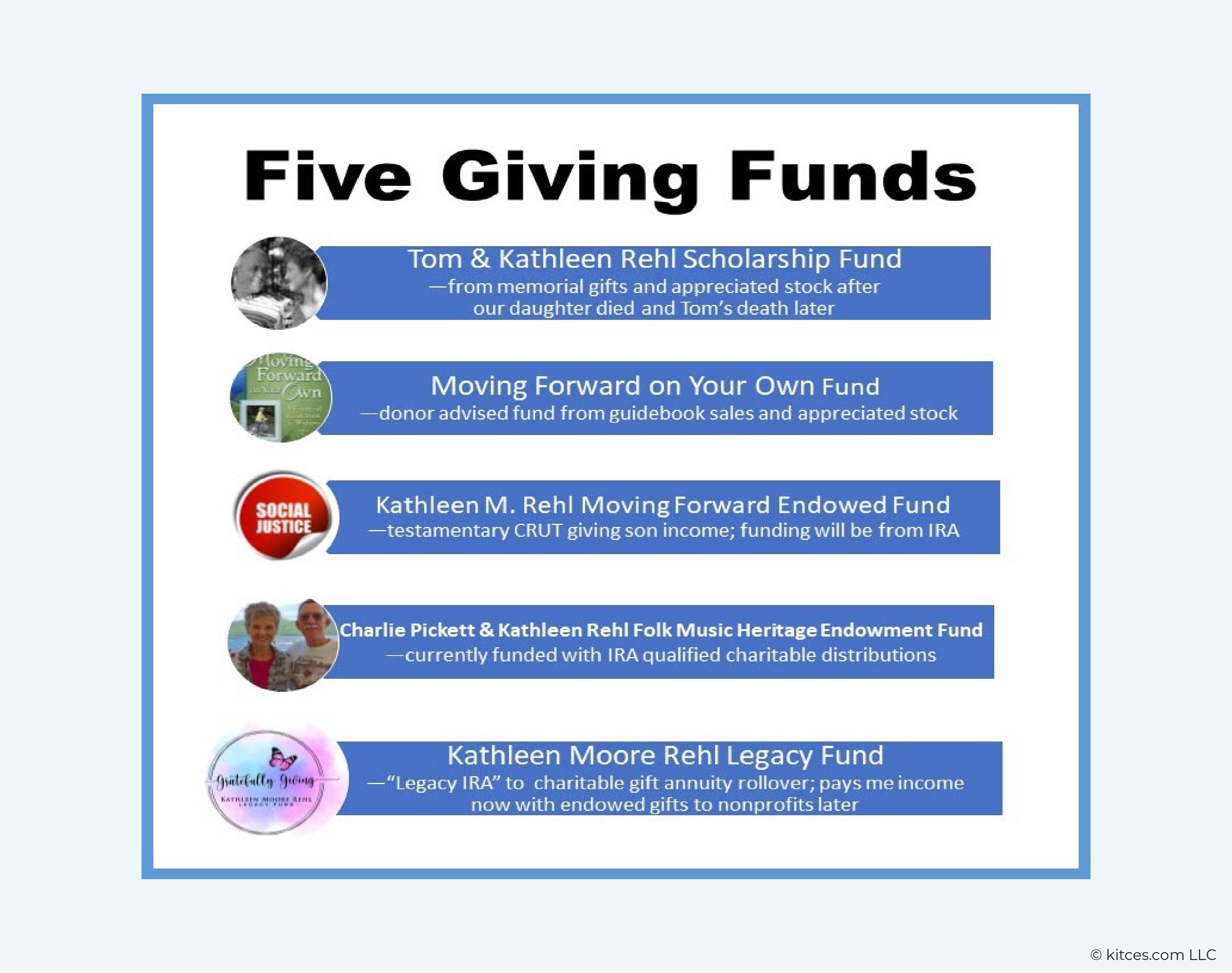
My adult children know about what I'm doing and are supportive. Indeed, during the end-of-year holidays, each of their families identifies a charitable organization to receive a special gift in their honor from my donor-advised fund. Later this year, I'll encourage both of my 7-year-old grandsons to be part of their family's discussion so they, too, can experience the joy of giving.


